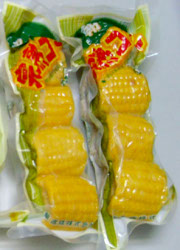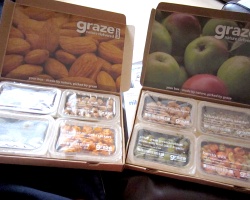 At one point during the cheese course thing at the weekend, the topic of conversation turned to packaging. For us hobbyist cheese makers, it’s not an issue but for the guy running the course and the woman hoping to set up a small scale cheese company, it’s an important thing to consider: balancing appearance with food safety/durability, cost and, of course, the environmental impact.
At one point during the cheese course thing at the weekend, the topic of conversation turned to packaging. For us hobbyist cheese makers, it’s not an issue but for the guy running the course and the woman hoping to set up a small scale cheese company, it’s an important thing to consider: balancing appearance with food safety/durability, cost and, of course, the environmental impact.
Both of them were considering the well-trodden route for pre-packed cheese packaging – vacuum packed in pretty plastic wrapping – because it seems lower waste than the current option (clear plastic wrap then paper/cardboard to make them more presentable). But because you invariably have to cut into such wrapping to open it, it can’t be reused (it’s seldom even good enough to continue using around the remainder of the half-eaten product) and while the plastic – typically polythene (LDPE, resin code 4) – can be recycled, it’s not kerbside recycled everywhere and crucially, it’s often not marked so people don’t know it can be recycled.
The cheese wrapping discussion got me thinking about packaging in general, and about something I’d been thinking about since my Graze box rant last week. Following the 3Rs, we should first REDUCE, before thinking about REUSING and RECYCLING – but sometimes, in some situations, it seems better to get a larger amount/weight of packaging that’s easier to reuse or recycle.
A few examples:
- The supermarket near me sells luxury pâté in a vacuum sealed pack but the cheaper stuff in a little plastic tub. The plastic tub is heavier/sturdier so used more natural resources in its manufacture but now I can reuse it for storing small quantities of leftovers etc.
- In the past, we’ve bought luxury ready-meal desserts in reusable dishes – souffles in glass ramekins and crème brulees in shallow glazed terracotta bowls. Both the ramekins & terracotta bowls have entered our crockery supply and been in circulation for years. Plastic tubs, even reused a few times, would probably have well gone by now.
- I pick pickles & condiments in heavy glass jars rather than light, unbreakable plastic squeezy bottles because glass recycling is more efficient than plastic (and here, we can doorstep recycle glass but not plastic). I can also reuse the glass jars for preserving, saving me from having to buy new jars for that.
So what do you think? Would you prefer items to be packed in the least amount of packaging possible or prefer more packaging but something more reusable or easier to recycle? Would/do you pay more for items with reusable/recyclable packaging?
Categories: food, packaging, reduce this
Posted by louisa
on 9 September 2010
 We’ve had an email from Jess:
We’ve had an email from Jess:
What can I do with my little girl’s cot now she’s too big for it? We’re not having any more so don’t want to keep it and I know you’re not supposed to use second hand beds for babies.
There is apparently an increased risk of cot death if the mattress has been used by a child in another home – but it’s the mattress not the whole cot/crib. All sorts of second-hand baby furniture is available via eBay, Freecycle/Freegle or NCT Nearly New Sales, so you should feel free to sell/pass yours on with a clear conscience.
While it’s best to keep using it for its original purpose for as long as possible, I know they’re reused in fun ways too – a blog I read, I forget which, showed one flipped upside down in a larger chicken run as a broody chicken house, and I’ve seen them used as growing containers in the garden – the plants either tied or climbing up the bars.
Any other suggestions for how to pass them on? Or for reuses around the home and garden?
(Photo by levigruber)
Categories: baby, household
Posted by louisa
on 8 September 2010
 Apologies for not posting yesterday – I was away on an “introduction to cheesemaking” course over the weekend and too tired to type yesterday ;)
Apologies for not posting yesterday – I was away on an “introduction to cheesemaking” course over the weekend and too tired to type yesterday ;)
I’ve been making super-easy cheeses like paneer for a few years now but before I committed to anything that needed months of effort/ageing, I wanted to learn some core skills from someone who knows what they’re doing. The course, through the Low Impact Living Initiative, was great for that and very very interesting – so now I have a burning desire to make all sorts of cheeses – and that requires moulds.
We saw a selection of stainless steel moulds and (food-grade) plastic ones – and someone else on the course mentioned they’d heard about moulds made from drainpipes. The course leader didn’t exactly advocate that but said that in theory, it would be fine — just drill holes in the rigid sides, making sure the outside of the hole was wider than the inside, and that there was no jagged bits of plastic left on the inside or outside of the holes.
So that got me thinking: what else could cheese moulds be made from? Any food-grade plastic packaging perfect for reusing? Or do any other household/kitchen utensils lend themselves to being used as cheese moulds – either as they are or with a bit of modification? Because it’s just for my consumption, I’m not bothered about them being pretty round cheeses.
If you make your own cheese, what do you use?
Categories: hobbies, household, kitchen, reverse this
Posted by louisa
on 7 September 2010
 Ok, this is a bit of a rant dressed up as a Recycle This style question – it’s a genuine question but I feel the need to rant too! ;)
Ok, this is a bit of a rant dressed up as a Recycle This style question – it’s a genuine question but I feel the need to rant too! ;)
So many people in my (geeky) world are going nuts for these at the moment and it makes me want to cry — all the packaging, all the waste.
Graze boxes are designed to lure people away from vending machines and sugary snacks at work and get them eating more natural, healthier alternative instead. For £3.29 a pop, you get a box of snacks delivered to your desk instead – four different snacks (such as dried fruit, nuts, seeds, olives or crackers) inside little film-covered plastic tubs and encased in a cardboard box. The idea is to have them delivered regularly – several times a week – so you’re never tempted by that Mars bar or long-life vacuum-sealed muffin.
Graze’s claim to have thought carefully about the packaging – the cardboard is from a sustainable forest, is designed to be use as little material as possible & can easily be recycled again, and Mrs G from My Zero Waste asked about the plastic of the pots and it’s apparently PETE (resin code 1) which is widely recyclable where plastics are recycled.
Yes, it’s good news that the plastic is widely recyclable plastic – but getting a pack of it delivered to your door is hardly reducing waste (the first and most important of the 3Rs) and it’s not obviously reusable either. Where plastics aren’t kerbside recyclable, that PETE is likely to end up in the bin – and even the cardboard might too since offices don’t always have full recycling facilities.
(I’ll try to remain on topic with my rant here and not get into: i. how much energy is wasted transporting these light but bulky items around the country; ii. how much more expensive they are than buying the items directly; iii. how it’s easier to buy something than make a genuine lifestyle change.)
Anyway, I think you probably get the gist of my annoyance so let’s get constructive instead: the packaging can be recycled where facilities are available, any reuse suggestions though?
And what about reducing people’s use of them? Do you have any tips or suggestions how people could have the same healthy snacking experience without so much packaging?
(PS. sorry for the ranting ;) )
(CCA Photo by philcampbell)
Categories: food, items, office, packaging, reduce this
Posted by louisa
on 3 September 2010
 I regularly get emails from people involved with small charities asking how to set up recycling programs that will help them raise money for their cause.
I regularly get emails from people involved with small charities asking how to set up recycling programs that will help them raise money for their cause.
Collection/recycling programs have been part of charity fundraising for a long time, but recently most seem to have moved from collecting large amounts of low value items (such as stamps or milk bottle tops) to collecting more valuable items (such as broken jewellery, mobile phones or toner cartridges). There is a lot of competition now for those type of items – not only between the charities but because it’s so easy for people to sell them online themselves – but it’s still a good income stream for certain charities.
So how can smaller charities set up their own recycling schemes?
Continue Reading →
Categories: business
Posted by louisa
on 2 September 2010
 At one point during the cheese course thing at the weekend, the topic of conversation turned to packaging. For us hobbyist cheese makers, it’s not an issue but for the guy running the course and the woman hoping to set up a small scale cheese company, it’s an important thing to consider: balancing appearance with food safety/durability, cost and, of course, the environmental impact.
At one point during the cheese course thing at the weekend, the topic of conversation turned to packaging. For us hobbyist cheese makers, it’s not an issue but for the guy running the course and the woman hoping to set up a small scale cheese company, it’s an important thing to consider: balancing appearance with food safety/durability, cost and, of course, the environmental impact.


 We’ve had an email from Jess:
We’ve had an email from Jess: Apologies for not posting yesterday – I was away on an “introduction to cheesemaking” course over the weekend and too tired to type yesterday ;)
Apologies for not posting yesterday – I was away on an “introduction to cheesemaking” course over the weekend and too tired to type yesterday ;) Ok, this is a bit of a rant dressed up as a Recycle This style question – it’s a genuine question but I feel the need to rant too! ;)
Ok, this is a bit of a rant dressed up as a Recycle This style question – it’s a genuine question but I feel the need to rant too! ;) I regularly get emails from people involved with small charities asking how to set up recycling programs that will help them raise money for their cause.
I regularly get emails from people involved with small charities asking how to set up recycling programs that will help them raise money for their cause.














